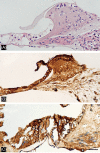Progenitor cell therapy for acquired pediatric nervous system injury: Traumatic brain injury and acquired sensorineural hearing loss
- PMID: 33034162
- PMCID: PMC7848325
- DOI: 10.1002/sctm.20-0026
Progenitor cell therapy for acquired pediatric nervous system injury: Traumatic brain injury and acquired sensorineural hearing loss
Abstract
While cell therapies hold remarkable promise for replacing injured cells and repairing damaged tissues, cell replacement is not the only means by which these therapies can achieve therapeutic effect. For example, recent publications show that treatment with varieties of adult, multipotent stem cells can improve outcomes in patients with neurological conditions such as traumatic brain injury and hearing loss without directly replacing damaged or lost cells. As the immune system plays a central role in injury response and tissue repair, we here suggest that multipotent stem cell therapies achieve therapeutic effect by altering the immune response to injury, thereby limiting damage due to inflammation and possibly promoting repair. These findings argue for a broader understanding of the mechanisms by which cell therapies can benefit patients.
Keywords: autologous stem cell transplantation; bone marrow; clinical translation; progenitor cells; umbilical cord blood.
© 2020 The Authors. STEM CELLS TRANSLATIONAL MEDICINE published by Wiley Periodicals LLC on behalf of AlphaMed Press.
Conflict of interest statement
The authors declared no potential conflicts of interest.
Figures




Similar articles
-
Treating childhood traumatic brain injury with autologous stem cell therapy.Expert Opin Biol Ther. 2018 May;18(5):515-524. doi: 10.1080/14712598.2018.1439473. Epub 2018 Feb 15. Expert Opin Biol Ther. 2018. PMID: 29421958 Free PMC article. Review.
-
Recent advances in the treatment of traumatic brain injury with autologous and non-autologous multipotent stem and progenitor cells: preclinical models and clinical trials.Folia Neuropathol. 2021;59(3):298-316. doi: 10.5114/fn.2021.108536. Folia Neuropathol. 2021. PMID: 34628796 Review.
-
The use of bioactive matrices in regenerative therapies for traumatic brain injury.Acta Biomater. 2020 Jan 15;102:1-12. doi: 10.1016/j.actbio.2019.11.032. Epub 2019 Nov 18. Acta Biomater. 2020. PMID: 31751809 Review.
-
Traumatic Brain Injury and Stem Cells: An Overview of Clinical Trials, the Current Treatments and Future Therapeutic Approaches.Medicina (Kaunas). 2020 Mar 19;56(3):137. doi: 10.3390/medicina56030137. Medicina (Kaunas). 2020. PMID: 32204311 Free PMC article. Review.
-
Stem Cell-Based Therapeutic Approaches to Restore Sensorineural Hearing Loss in Mammals.Neural Plast. 2020 Aug 1;2020:8829660. doi: 10.1155/2020/8829660. eCollection 2020. Neural Plast. 2020. PMID: 32802037 Free PMC article. Review.
Cited by
-
Research progress on the treatment and nursing of sensorineural hearing loss.Front Neurosci. 2023 Jun 6;17:1199946. doi: 10.3389/fnins.2023.1199946. eCollection 2023. Front Neurosci. 2023. PMID: 37346087 Free PMC article. Review.
-
Mitochondrial redox system: A key target of antioxidant therapy to prevent acquired sensorineural hearing loss.Front Pharmacol. 2023 Mar 31;14:1176881. doi: 10.3389/fphar.2023.1176881. eCollection 2023. Front Pharmacol. 2023. PMID: 37063286 Free PMC article. Review.
-
The audiogram: Detection of pure-tone stimuli in ototoxicity monitoring and assessments of investigational medicines for the inner ear.J Acoust Soc Am. 2022 Jul;152(1):470. doi: 10.1121/10.0011739. J Acoust Soc Am. 2022. PMID: 35931504 Free PMC article. Review.
-
Traumatic brain injuries in children during COVID-19 pandemic: a national report from northern Iran.Int J Burns Trauma. 2022 Aug 15;12(4):175-179. eCollection 2022. Int J Burns Trauma. 2022. PMID: 36160672 Free PMC article.
References
-
- Centers for Disease Control and Prevention . WISCARS. Leading Causes of Death Reports, National and Regional, 1999–2013; 2015. http://webappa.cdc.gov/cgi-bin/broker.exe. Accessed September 22, 2015
-
- Langlois J, Rutland‐Brown W, Thomas K. Traumatic Brain injury in the United States: Emergency Department Visits, Hospitalizations, and Deaths. Atlanta: Centers for Disease Control and Prevention, National Center for injury Prevention and Control; 2004. https://www.cdc.gov/traumaticbraininjury/tbi_ed.html. Accessed September 22, 2015.
-
- Injury Prevention and Control: Traumatic Brain Injury Centers for Disease Control and Prevention. http://www.cdc.gov/traumaticbraininjury/data/dist_death.html. Accessed September 22, 2015
Publication types
MeSH terms
LinkOut - more resources
Full Text Sources
Medical
Research Materials

